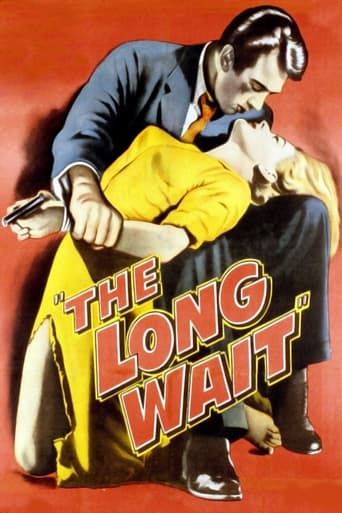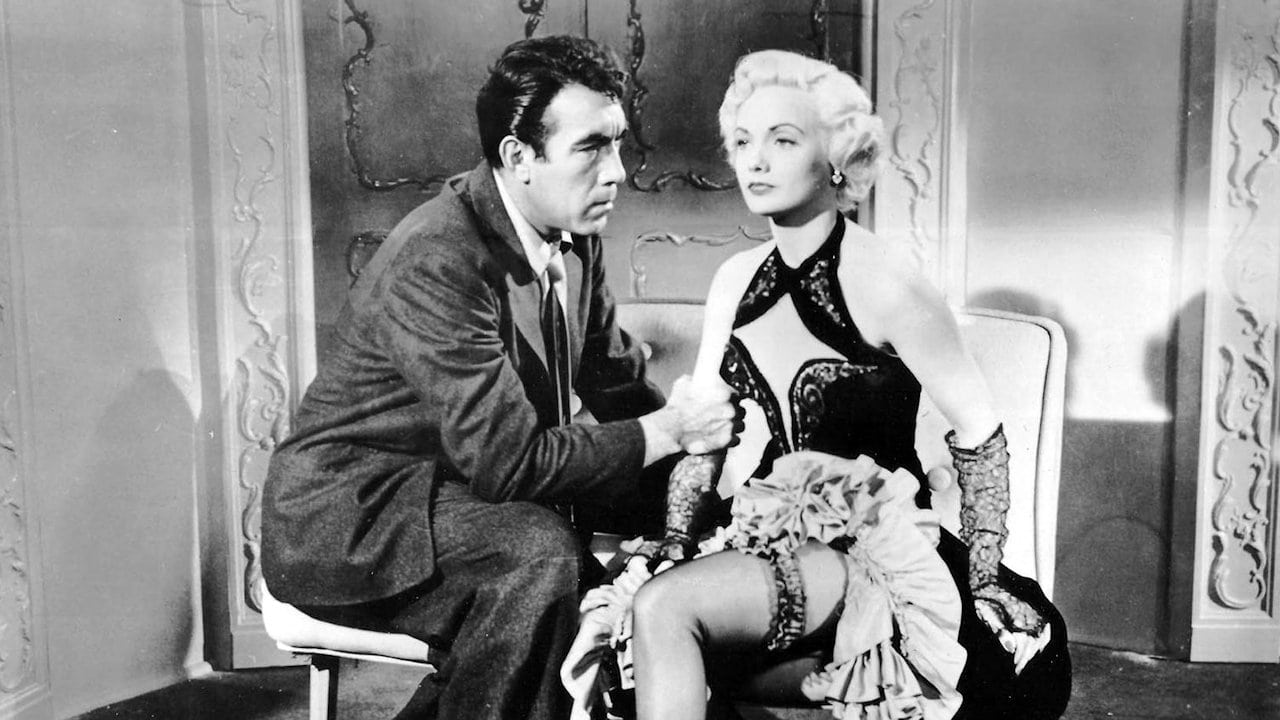HotToastyRag
If you liked Mirage, rent The Long Wait. It came ten years earlier, but it feels like a poor man's Mirage. Anthony Quinn stars in the film adaptation of Mickey Spillane's novel. He survives a terrible car accident, with amnesia and burned hands as his souvenirs. He has no memory of his past, but when he finds out he's wanted for murder, he has to work quickly to prove his innocence. This is actually a pretty entertaining flick, with plenty of eye candy and good acting from Tony. The only detriments were the leading ladies in the film. They looked so much alike, I kept getting them confused, and their collective talent was maybe one tenth that of a normal actress. The only way I was able to excuse it was to believe they were all cast as favors to producers, and in the story, they all were supposed to look similar. Tony is trying to find a girl from his past, and he-and the audience-can't tell if she's Peggie Castle, Shirley Patterson, Dolores Donlon, or Mary Ellen Kay. I didn't really like being confused, but that was the point.Charles Coburn adds a bit of class to the movie and somewhat makes up for the lousy acting of the four women. Really, though, it's Tony's show. Without him, it would be a terrible B-picture with low energy and bad pacing. Tony's incapable of giving a low energy performance, and he adds a fantastic spice to the tension-filled scenes with the ladies. And if you're wondering how many of the girls he romances, the answer is all of them. Want to rent it now?
Spikeopath
The Long Wait is directed by Victor Saville and adapted to screenplay by Alan Green and Lesser Samuels from the Mickey Spillane novel. It stars Anthony Quinn, Charles Coburn, Gene Evans, Peggie Castle, Mary Ellen Kay and Shirley Patterson. Music is by Mario Castelnuovo- Tedesco and cinematography by Franz Planer.Johnny McBride (Quinn) is a amnesiac who manages to get back to his home town of Lyncastle where he hopes to unravel who he is. But pretty soon he finds himself in a quagmire of trouble and strife...Every once in a while I come across an instance like this, where a film noir picture's reviews back upon its release were savage, and yet today the more modern noir lover is mostly positive about the pic. In fact IMDb's rating sits currently at 7.2, which as the site's users will attest to, is pretty good going. So where we at with this Spillane revamp?The complaints back in the day about it being dull and boring smack to me of writers back then not exactly understanding the noir ethos, though it's noted that there is the odd modern reviewer sharing the same complaint. It's a film very much erring on the side of bleak and moody, dabbling in the complexities of the human condition, and it's done very well, though the screenplay is hardly minus plot holes and is full of incredulous set-ups.We also have to buy into Quinn being catnip to the dames, four of them no less! But Quinn does angry and broody very well, and he gets to do lots of both here. The aura of a town paddling in its own muck is evident, the amnesia angle merely an excuse to keep things on the side of murky, for it's imperative that we feel Johnny McBride's confusion and mistrust, and we do. All of which is framed superbly by Planer's (Criss Cross) photography, which never misses a chance for shadows and low lights.With salty villains and sultry dames, violence and choice dialogue, and a few superb scenes (one sequence in an empty warehouse is stunning), this is very much a noir for noir lovers to sample. But with that in mind, these warnings should be noted, that as is often the way in noirville, the ending is divisive and the overt misogyny could well offend. 6.5/10
morrison-dylan-fan
With a poll coming up on IMDb's Classic Film board for the best titles of 1954,I started to search around for near-forgotten Film Noirs to view.With having heard about lead actor Anthony Quinn,I was thrilled to stumble up on a title,which would hopefully make the long wait I've had of seeing Quinn on screen something that was worth waiting for.The plot:Hitch-hiking Johnny McBride gets a lift from a driver,who ends up crashing his car and leaving McBride in a coma for 2 years.2 Years later:Waking up from the coma McBride discovers that along with his finger prints having been burnt off in the crash,that he is also suffering from amnesia,with any type of ID that McBride owned having been burnt in the crash.Walking out of hospital at last,McBride starts attempting to put his life back together.Meeting 2 people who claim to be friends,McBride is told to go to a small town,due to a shop in the area having a photo of him.Unknown to McBride,the 2 friends are actually people who want to claim a reward over McBride being linked to a bank robbery and a murder.Reaching the town,McBride soon run into 2 police officers who arrest him for murder.With their main piece of evidence being the finger prints on a gun that McBride used to rob a bank that he worked at,the cops are horrified to discover,that all of McBride's finger prints have been burnt off.Horrified by the allegations,McBride decides that he has waited long enough to start search around the city's underground,in the hope of uncovering his long forgotten past.View on the film:For their adaptation of Mickey Spillane's novel,writers Alan Green and Lesser Samuels smartly keep the audiences unrevealing of the past at the same distance that McBride is heading towards,which allow for each of the films sharp twist & turns to strike the viewer with the same shock that they hit McBride with.Whilst the ending is disappointingly up- beat,for the rest of the running time,the writers create a wonderfully grim Film Noir world.Giving some strong hints that McBride has shell shock from serving time in the war as he obsessively searches for his near-mythical dame,the writers paint the world that McBride attempts to remember as one that's rotten to the core,as McBride discovers to his horror that he may be linked to an underworld which has got a firm grip on the entire city.Wrapping the city in shadows as McBride goes in search of his past, director Victor Saville and cinematographer Franz Planer build an atmospheric city which is covered in dirt,with Savile and Planer making every street look like it has been infected with the characters morals,as each building appears to be rotting away.Along with the filthy Film Noir streets,Savile and Planer cake McBride's (played by an amazing,rough Anthony Quinn) in sweat,which drips across the floor as he delves deeper into the underbelly of the city and uncovers the past which he has long waited to find.
bmacv
Contemporaneous with the noir cycle came the rise of the cheap paperback, bringing lurid crime novels with provocative cover art to racks in drugstores and bus depots. Spearheading this pulp revolution were the scribbles of Mickey Spillane, several of which became films: I, The Jury; The Long Wait; My Gun Is Quick; and Kiss Me Deadly the only indispensable title among them.The Long Wait remains anomalous in that Spillane's thuggish protagonist, Mike Hammer, makes no appearance. Anthony Quinn hitches a ride in a car which promptly plunges into a ravine and bursts into flame. In the fire, he loses both his fingerprints and his memory. After two years working in an oil field, he's sent on a wild-goose chase to his home town, unaware that he's wanted for the murder of the District Attorney, who was prosecuting him for embezzling a quarter-million. His cauterized fingertips force the police to release him, but other parties want him dead. But he forges ahead with a two-pronged quest: to vindicate himself, and to find the girl he's told he once loved. She used to be called Vera shades of Moose Malloy and Velma in Murder, My Sweet (Farewell, My Lovely) but now she's...somebody else. The four prime candidates for Verahood (Peggie Castle, Mary Ellen Kay, Shawn Smith and Dolores Donlon) become pasteboard targets at which Spillane can spew out his misogynistic venom. They're nothing more than scheming nymphos, throwing themselves at Quinn despite any prior arrangements they've made to insure their kept-women comforts. Inevitably they're terrorized and slapped around. The movie's most visually arresting sequence (thanks to cinematographer Frank, or Franz, Planer) proves also its most sadistic: in an abandoned factory, lit with Expressionistic panache, Castle, bound with rope and under the muzzle of a gun, crawls across the floor to give Quinn a final kiss. Aficionados of film noir must, of course, grapple with the nettlesome problem of the femme fatale, the alluring but heartless Lilith who brings men gladly to ruin. But The Long Wait preserves an unregenerate, macho view of womankind that surpasses the merely dated or distasteful. It's a movie about the corruption of a small city that never questions the corruption of its own vision.


 AD
AD


